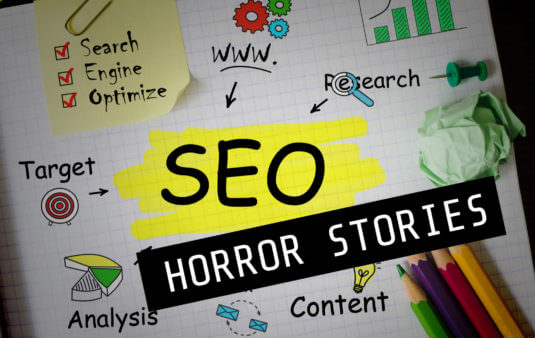SEO horror stories: Here’s what not to do
These three real-life case studies are anonymized to share textbook examples of how not to approach search engine optimization.
Obviously, few people are inclined, let alone feel comfortable, disclosing any disasters of their own making to the interested public. That’s why the following three real-life cases are completely anonymized. They are textbook examples of how not to approach search engine optimization: All three websites were, at the time of the disaster, primarily focused on non-English speaking markets. They all did reasonably well in Google Search. Furthermore, in all three of these cases, poorly informed decisions set a disastrous chain of events in motion.
Most of these businesses eventually recovered. And lastly, none of the experiences shared below pertain to a past or present client or business partner.
Example 1: PremiumRetailWebsite
Over the course of a few years, PremiumRetailWebsite, an online store for jewelry, has developed from a sideshow to the main sales channel, outperforming the brick and mortar showrooms it was supposed to merely support.
In total, a few thousand product landing pages did reasonably well without much oversight, up until the moment the decision was made to move from the lengthy domain name to a much shorter, more memorable one. A common enough situation in the online world, yet basic mistakes were made from the beginning.
No technical audit was performed and no legacy issues were addressed prior to the move. Instead, a crude 1-1 move from the old domain A to a new domain B was planned. With a 301 redirect to the root rule for any outdated, sold-out or discontinued content applied broadly in the process. A mishandled migration like this alone was likely to cause new problems and magnify existing ones.
When content migration is done, Google has to recrawl new URLs, along with all of their accompanying signals, such as backlinks and canonicals, in order to rank what effectively becomes brand new landing pages. Under any circumstances, a migration is best prepared months in advance, carefully planned and executed during a sales low season. In the case of PremiumRetailWebsite, all of the points were disregarded, causing — as expected — an instant drop in Google rankings at the end of Q3.
The site may have recovered over time; however, the migration was rolled back several weeks later due to an unexpected legal issue that arose with the new domain B. In desperation, an aftermarket domain C was swiftly acquired and the migration was performed once more, now to domain C. This unfortunate course of events was further compounded by the fact that domain C’s past and backlink profile were not checked as part of due diligence.
An existing manual penalty, also known as a manual action, took the SERP slide into a nosedive. The final blow for the site rankings was dealt thereafter when, amid the turmoil, website operations were restructured to more closely mirror the countries’ sales teams. In short succession, PremiumRetailWebsite language versions were upgraded with a multitude of homegrown and customized third party CMS’, operated independently on subdomain and directories. Any resemblance of consistency was abandoned due to internal strife. Too many cooks did spoil the SEO broth at last.

Takeaways:
- Content migrations are among the most sensitive SEO operations. They require thorough preparation and must never be executed without previously auditing the current state of affairs.
- Any penalty can be lifted and any checkered domain past expunged; however, this is a step that must be factored into the preparation process.
- Website operations can never be surrendered to the dominion of local or regional sales teams. Technical, content, on- and off-page signal consistency is a key element for success.
Example 2: JourneyCompareHeaven
JourneyCompareHeaven was once a leading travel aggregator in central Europe. Operating successfully in a competitive market, the website operators discovered tremendous growth opportunities for the business if a larger market share could be carved out.
On the basis of that premise, thought was given to increasing SERP visibility by growing the volume of landing pages. Expansion plans to neighboring countries and markets were expedited. A modest 500 thousand desirable landing pages were swiftly auto-translated into another five languages. This step alone was sure to cause serious problems because the content wasn’t localized, which had to impact user satisfaction and rankings down the line.
Content quality considerations aside, the truly calamitous decision to open landing page option filtering for indexing was made. Once that happened, the combined approximately 3 million landing pages exploded in SERPs. With non-existent content quality oversight, indexable filtering and no canonicals, the total number of landing pages could not be precisely gauged — a conservative estimate at the time was about 1 billion landing pages.
Suddenly, Google had to crawl and index thousands of landing pages in order to rank even just one. The URL increase alone did not pose an issue for Google, yet with steadily declining quality and user signals, before long, crawl budget allocation declined.
Consequently, Googlebot began revisiting old URLs as well as detecting new ones progressively less often. In a fast-paced industry, with ever-changing offers, this was of course bound to further reduce relevance for users and diminish users’ signals. A vicious cycle was created. With only scant web server logs temporarily recorded and a recrawl cycle completed only within months, recovery, even though feasible, became a prolonged uphill battle.
Takeaways:
- More indexable landing pages doesn’t mean more relevant, converting traffic. It is frequently the opposite, in fact. Only more compelling content landing pages are beneficial.
- Market expansion must be planned with consideration for specific market requirements and executed through localization, not mere content translation.
- Web server logs must be recorded and preserved for crawl management evaluation.

Example 3: MedicineMakesHappy
This last real-life case is a classic tale of overreaching. MedicineMakesHappy, a medical services platform with reviews, compelling content and added value such as appointment scheduling services, has successfully maintained their leadership position in a firmly narrow market. With high brand recognition, positive user signals, solid site performance and consistent quality management, the website visibility was good and on an upwards trajectory.
A third-party agency took care of ongoing marketing efforts, both on- and offline. With demand for cosmetic services growing, the idea to address users’ needs and claim leadership in this specific, high-revenue niche was conceived.
In collaboration with the third-party agency, an outreach and link building campaign was launched. The backlink profile of several years past wasn’t audited, therefore risk levels remained unknown. An already steadily growing backlink profile now suddenly shot up and kept growing fast. The total volume of existing backlinks was approximately 1 million, of which few could be considered merit-based by Google standards. It rapidly grew to over 7 million.
None of the recently built backlinks were Google Webmaster Guidelines compliant. The ongoing campaign utilized primarily PageRank-passing guest blogs with commercial, hard anchor texts. Before long, a manual action due to link building was issued. Because of the intensely competitive nature of the market, it is possible that a compelling competitor spam report helped to bring the situation to Google’s attention.
A wide, albeit moderate, drop in visibility was followed by a slow rankings decline. Meanwhile, further link building continued, as hastily submitted reconsideration requests were rejected, one after another. As the SERP situation deteriorated, the communication with the agency first soured, then the collaboration was terminated without the problem being resolved. Only then was PageRank-passing link building campaign halted.
Over the subsequent two quarters, SERP visibility continued to degenerate with a lingering active manual penalty. During that period, new site releases had to be put on hold since its impact could not be accurately measured. Periodic attempts to resolve the penalty using Google Search Console backlink samples failed.
Eventually, another third party, specializing in penalty recovery, collected and analyzed historic, as well as fresh backlink data over an extended period of time. The analysis uncovered substantial legacy backlink risks, including long-forgotten directory, press release and prehistoric XRumer backlinks conceived many years back.
Ultimately the goal to resolve the manual spam action was met, which helped to stabilize Google visibility somehow, albeit not at a level as high as prior to penalization. That objective was eventually achieved several months later when yet untapped site performance potential was uncovered with a technical audit.
Takeaways:
- Spam methods, even when used unbeknownst to the website operator, increase risk. They also magnify lingering legacy Google Guidelines violations.
- Third-party link building must be documented. Backlinks should be built exclusively for content discovery, searchbot crawl prioritization, user navigation and converting traffic purposes.
- Any manual penalty can and should be resolved. Any drop in rankings is an opportunity to leverage for new highs in organic search.

In addition to the takeaways already highlighted, there is another silver lining to these cases: The affected sites all had a well defined unique selling proposition. They all stood a good chance to recover from their self-inflicted SEO hangover, even to improve their organic search performance significantly beyond what was deemed their SERP ceiling in the past.
Any legitimate website, even without prior near-catastrophic SEO incidents, has the potential to much improve their signals. Facing imminent disaster, however, increases the pressure to act decisively. Provided that the resources available are concentrated and committed to current best practices, not mere recovery but visibility to the full potential of the website should be the goal to strive for.



